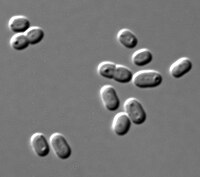
Photo from wikipedia
Spermidine synthase (Spds) catalyzes the formation of spermidine by transferring the aminopropyl group from decarboxylated S-adenosylmethionine (dcSAM) to putrescine. The Synechococcus spds gene encoding Spds was expressed in Escherichia coli.… Click to show full abstract
Spermidine synthase (Spds) catalyzes the formation of spermidine by transferring the aminopropyl group from decarboxylated S-adenosylmethionine (dcSAM) to putrescine. The Synechococcus spds gene encoding Spds was expressed in Escherichia coli. The purified recombinant enzyme had a molecular mass of 33 kDa and showed optimal activity at pH 7.5, 37 °C. The enzyme had higher affinity for dcSAM (Km, 20 µM) than for putrescine (Km, 111 µM) and was highly specific towards the diamine putrescine with no activity observed towards longer chain diamines. The three-dimensional structural model for Synechococcus Spds revealed that most of the ligand binding residues in Spds from Synechococcus sp. PCC 7942 are identical to those of human and parasite Spds. Based on the model, the highly conserved acidic residues, Asp89, Asp159 and Asp162, are involved in the binding of substrates putrescine and dcSAM and Pro166 seems to confer substrate specificity towards putrescine.
Journal Title: World Journal of Microbiology and Biotechnology
Year Published: 2017
Link to full text (if available)
Share on Social Media: Sign Up to like & get
recommendations!